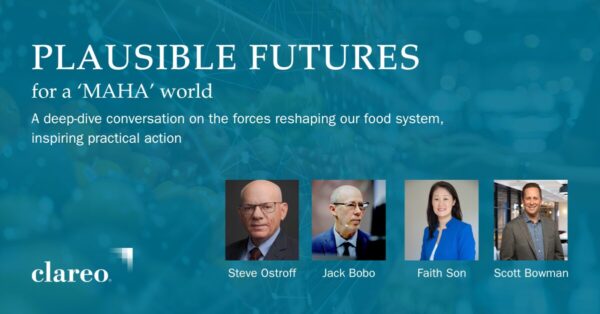Scott Bowman, Managing Director, Clareo and co-founder of The NOURISH Movement, moderated Day Two at the Food as Medicine Summit 2025, Chicago. The below is a summary of Scott’s closing session at the Summit.
When the right people gather in the same room, breakthrough insights emerge. The Food as Medicine Summit 2025 delivered exactly this dynamic. The bottom line:
Food as medicine is evolving fast – from patient to consumer, from intervention to sustainable change – and it has potential to become a critical component of healthcare transformation.
The challenge now is execution: building the ecosystems, business models, and partnerships that can move from invisible success stories to visible, systemic solutions that can move from pilot programs to scaled impact.
Four Critical Shifts for System Change
Looking across conversations with practitioners spanning the entire spectrum, from individuals trying to access healthy food to health system executives designing programs for thousands, Scott believes there are four critical shifts that must happen simultaneously for anyone in this ecosystem to succeed at scale:
1. Systems thinking over silos
“We need systems thinking. These complex issues require multiple stakeholders working together across sectors,” he observed. Healthcare and food ecosystems appear to work “in their own universes”, says Scott. The solution requires systemic, intentional ecosystem building that brings together unlikely partners around shared challenges. The goal? Eliminating sector silos and delivering actionable results.
At The NOURISH Movement, we’re currently doing this in our latest initiative, ‘Food as Medicine for a GLP-1 World’. We’re building:
- shared understanding of the problem and business case for action,
- shared vision for the solutions needed to accelerate innovation and
- shared actions – collectively and individually.
Our focus on the consumer journey map, innovation principles and retail activation pilots is a way we’re actively bringing together the ecosystems to drive from challenge to action.
2. Business model innovation
As Scott stressed in his panel, “Business model innovation needs wider thinking. We’ve got to get out of the mindset that we have to be 100% reliant upon government funding or foundation funding.”
In Clareo’s experience, business models are very sticky things: leaders in both the health and food sectors have optimized their businesses around their customers, products/services, and revenue models of today. Naturally, they bring legacy mindsets, thinking and assumptions to problems.
But this keeps them from anticipating, designing for and accelerating what’s next. At Clareo, we call this ‘the innovator’s paradox,’ and it happens in almost every industry. One of the best ways to overcome this is to organize around challenges rooted in innovation, which have clear potential for bringing economic and strategic value to the stakeholders involved.
How do businesses identify potential aligned interests with unlikely partners? We’d advise:
- Find challenges worth working on that have the potential to lead to opportunities for innovation in the private sector.
- Find an anchor willing to get behind it and be the organizer/convener.
- Build, socialize and drive buy-in on the case for action financially and strategically
- Curate and bring together the right group of leaders – those at the ‘right level’ to mobilize action within their organizations, and employ design thinking methods to define shared opportunities, vision, and shared actions
3. Curated Convenings with Purpose
As conversations and presentations rolled out over the two days of the Summit, Scott concluded that “beyond networking events, the FAM movement needs more curated convenings, courageous convenings, and convenings with purpose anchored around challenges rooted in innovation potential.” Leveraging the power of convening, like the Food as Medicine Summit 2025, for example, could focus on healthy workforces, new medication integration, or other areas where multiple stakeholders have recognised aligned interests.
The challenge, as Scott noted in the Forum’s closing discussion with Martin Tull, is that “transformative ideas exist but they’re trapped in silos and lack the ability to scale. Creative partnering and coalition building around shared purpose is what unlocks them.”
4. Engaging Cost Owners
“We need to engage the cost owners as part of the equation and identify what needs to be true for them to scale solutions,” Scott noted. As discussed in detail in an earlier panel on private/public funding, it’s vital to bring a broad set of stakeholders to the table, not only traditional and non-traditional food industries, but also the government, employers, individuals, and communities, and all those who bear the costs of diet-related chronic disease.
At Clareo and The NOURISH Movement, we drilled down into the definition of ‘cost owners’. Defining this group more closely, cost owners globally (all markets) are government, individuals (in our country) and employers (in our country). Note that insurance companies (whom we call ‘payors’) are not actually cost owners; they’re risk intermediaries. The true owners of the cost are those defined above. Employers, so far, have been on the sidelines – and yet they bear both the direct and indirect cost of health! Read more about our Case for Action for employers here and here.
Interestingly, insurance companies also have a vested interest in the communities in which they operate, as concerned stakeholders; hence we see real potential for them on many levels.
Envisioning success
As attendees heard so powerfully throughout the Summit, Food as Medicine is about giving people agency, giving them choice, giving them the ability to chart their own health destiny and create a fundamentally different future. The stakes extend beyond healthcare efficiency. It’s a fundamental shift in how our food system operates. When we align this broad ecosystem of players, we create something transformative, not just better chronic disease management, but genuine consumer empowerment.





